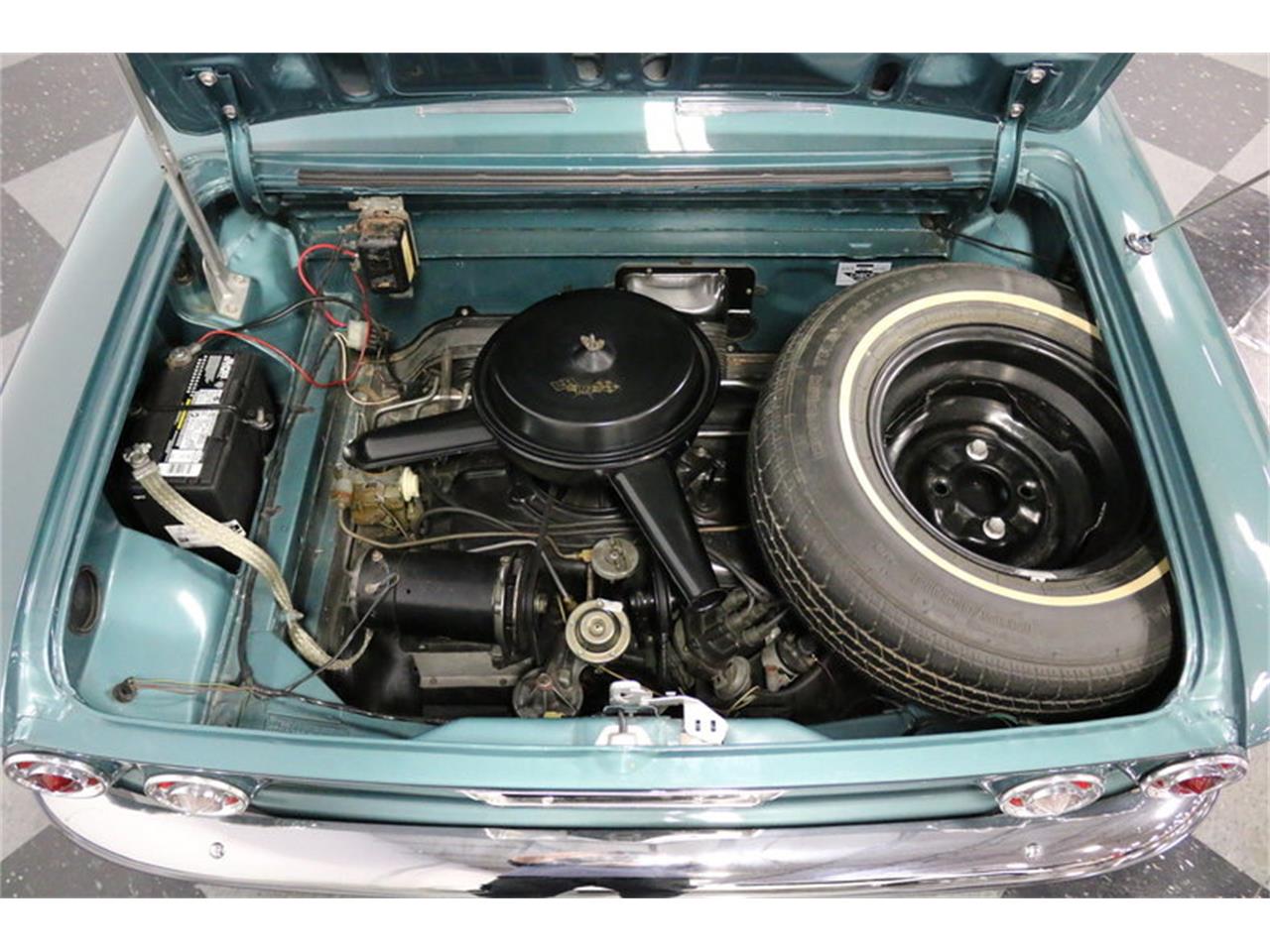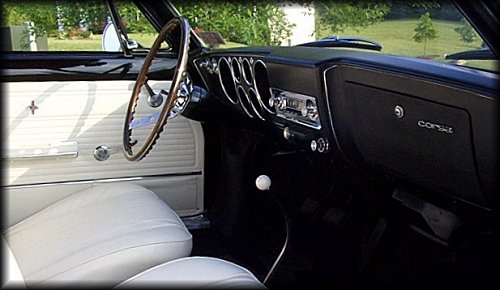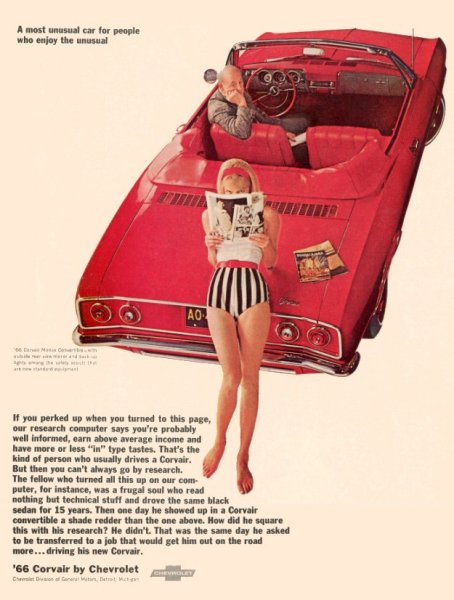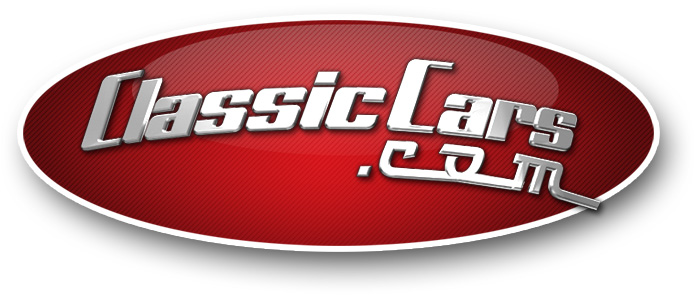Hello,
I am looking for a project 65-68 convertible.
Automatic is preferred.
Needs Title
I am located in Northern Colorado but willing to travel for the right car.
Thanks
AJ
WTB LM Convertible
Forum rules
All Classified posts will be automatically deleted approximately 90 days after posting.
All Classified posts will be automatically deleted approximately 90 days after posting.
WTB LM Convertible
1956 210
1969 Z/28
1972 K20
1973 Nova SS
1969 Z/28
1972 K20
1973 Nova SS
- bbodie52
- Corvair of the Month

- Posts: 11917
- Joined: Mon Aug 06, 2012 12:33 pm
- Location: Lake Chatuge Hayesville, NC
- Contact:
Re: WTB LM Convertible
Can you post some pictures of your current classic cars?
The Late Model Corvair convertible (1965-1969) is, unfortunately, the most vulnerable to body rot, rust, etc. that is sometimes beyond repair! The internal structure of the unibody Corvair convertible is very vulnerable to road salt damage and internal structure rusting in the unique reinforced area around the door perimeter. GM had to strengthen that area to compensate for the lack of a steel roofline. So be very cautious as you search for your "dream Corvair".1956 210
1969 Z/28
1972 K20
1973 Nova SS
My own experience with Corvairs began in 1961, when I was eight years old. We lived in San Jose, California at that time. My parents bought a new 1961 Corvair Monza coupe, and that was our family car for several years. In 1965 they traded up to a new 1965 Corvair Corsa convertible.
Warren Bodie and son Brad at Edwards AFB Air Show in 1965 with our new 1965 Corvair Corsa convertible (140HP)
When I joined the Air Force in 1972 and graduated from an electronics tech school, my parents surprised my pregnant wife and I with that same Corvair convertible (now painted green), which we drove from Southern California to our first USAF assignment at Robins AFB, Warner Robins, Georgia.
In 1980 I gave the convertible a fresh paint job in red, and a new convertible top, and we shipped the Corvair to our next USAF assignment in southwest Germany, near Ramstein Air Base.
I currently own a 1966 Corvair Corsa convertible and a 1966 Corvair Monza 4-door sedan. The latter has a Powerglide automatic and factory Air Conditioning. I guess I'm stubborn, and when I find something I like, I stick with it! The Corvair is still my "daily driver" — even as my wife and I approach age 71!
As a new Corvair enthusiast and potential owner, this material that I wrote some time ago may be helpful to you...
These website links may be helpful to you as you search for drivable, complete Corvairs. Here are several "Corvair For Sale" websites that may be useful...The Corvairs are vintage 1960s technology and design — easy to learn and easy to maintain. I would say that learning to work on a Corvair is analogous to an experienced home DIY "shade tree" car mechanic learning to work on a motorcycle. The concepts and procedures are very similar, but the details and the way it is put together is a little different. With the Corvair engine (like a motorcycle) you are dealing with a lot of aluminum. The metal is soft when compared to steel and cast iron, so the use of a torque wrench, anti-seize compound and carefully avoiding cross-threading becomes more important. Also, (like some motorcycles) you are dealing with multiple carburetors so tuning procedures are a little different. The use of Corvair shop manuals and supplements, other technical guides, and information sources like the Corvair Forum, and perhaps joining a CORSA (Corvair Society of America) club chapter can help you to quickly learn about Corvairs. Information resources, like good Corvair parts suppliers, are plentiful if you know where to look. Suppliers like Clark's Corvair Parts have been well-respected and extremely supportive since 1973, and suppliers like that make Corvair ownership more practical and much-more possible. I taught myself how to remove a Corvair powertrain, overhaul the engine, and rebuild the Powerglide transmission during my summer vacation in 1969, when I was sixteen years old. I was working alone (my father had been transferred by Lockheed from northern California to southern California, and we had not yet moved to join him). I had a shop manual and a garage full of tools. There was no Internet, no Corvair Forum, no CORSA club — I was pretty-much on my own. Yet I learned and was successful (in 1972 that engine carried me and my new bride on our wedding day and on our honeymoon).
So you should be able to master working on Corvairs without too much trouble — except watch out for rust and body rot! The Corvair is of unibody construction, so most body repair involves cutting and welding. The doors, trunk lid (in the front), and engine compartment lid (in the back)
and maybe the gas filler door are the only bolt-on body components. Everything else is cut and weld, and the body serves as the main chassis frame. So unless you are a master body repair technician, you need to select your Corvair carefully and avoid excessive hidden rust or a "Bondo bucket". The door frame areas, fenders, floor pan, the bottom of the trunk, lower windshield and battery area often rust and rot.
What follows is an attempt at introducing new prospective Corvair Owners to Corvairs and some of the issues involved. Food for thought, before you take the plunge. This is a copy of something I wrote earlier, but I think it may be helpful in your quest for the "right" Corvair...
bbodie52 wrote:I will try to provide a quick summary of the 1960-1969 Corvair lineup, and will also try to provide some answers regarding the use of a Corvair as a "daily driver".
EARLY MODEL: 1960 - 1964 Corvairs were the first generation. Their body style emulated other Chevrolet body styles from the early 1960s. The rear suspension was a swing-axle design that was similar to the Volkswagen "Beetle". The 1960 model year was the only year with a 140 cubic inch engine, and there were some characteristics that were unique to that model year only. A number of refinements were implemented in the following year, including some restyling of the front end and an increase in displacement to 145 cubic inches (CI). A manual choke was used in 1961, and this was changed to an automatic choke design in 1962 that remained with the car through 1969. A turbocharged 150 hp Spyder was introduced in 1962, and the Spyder name remained with the turbocharged engine through 1964. In 1964 the engine displacement in all Corvair engines increased from 145 CI to 164 CI. There were also some suspension refinements, including a front anti-sway bar and a rear transverse leaf spring to improve handling in all 1964 Corvairs. Here are a few pictures of Early Model (EM) 1960-1964 Corvairs...
1964 Monza Convertible
1964 Corvair Engine Compartment
1963 Monza Coupe
1963 Monza Interior
1962 Lakewood Station Wagon
Corvair Rampside Truck
Corvair Greenbrier Van
Van/Truck Interior
LATE MODEL:The 1965 Corvair introduced a completely new body style, that was also seen later in similar styles in the Camaro and Pontiac Firebird. The drum brake size was increased, and the swing-axle rear suspension design used in EM Corvairs was abandoned. The new rear suspension was a design lifted from the Corvette Stingray.
1965 and 1966 Corvairs were nearly identical. In 1967-69 the top of the line Corsa was dropped, leaving the Monza and economy 500 until production was discontinued in the spring of 1969. During the 1967-69 production period, there were minor safety changes, such as a dual master brake cylinder in place of the single unit used in 1960-1966. Interior seats and trim changed somewhat, paralleling the items used in Camaros and some other GM products during that period.
All 1965-66 Corsas came with a standard 4-carburetor 140 hp engine, and an optional 180 hp turbocharged engine. The 140 hp engine remained optional in the rest of the lineup. Other engine options in the Monza and 500 were 110 hp and 95 hp dual carburetor engines. All engines could be had with a manual 4-speed or 3-speed transmission, or with a 2-speed Powerglide automatic (with the exception of the 1965-66 turbocharged 180 hp engine, which was available with the Corsa only, and only with a 4-speed manual transmission).
Air conditioning was a rare option, but can be found in the 1965-1967 lineup, and some of the EM Corvairs as well. The following link will provide you with some air conditioned Corvair background and history...
http://www.corvair.org/chapters/airvairs/
The brakes, front and rear suspension, transaxle and body were essentially identical in the Corsa, Monza, and 500. The primary differences in the cars were the instrument panel (the Corsa had more gauges), trim details, and the engine option.
The late model Corvairs were available in a 2-door Coupe, 2-door Convertible, and 4-door Sedan. In 1968, the four-door hardtop was discontinued, leaving three models—the 500 and Monza Hardtop Coupes and the Monza Convertible. Air conditioning was dropped as an option. The weight of the cars was very similar in all configurations.
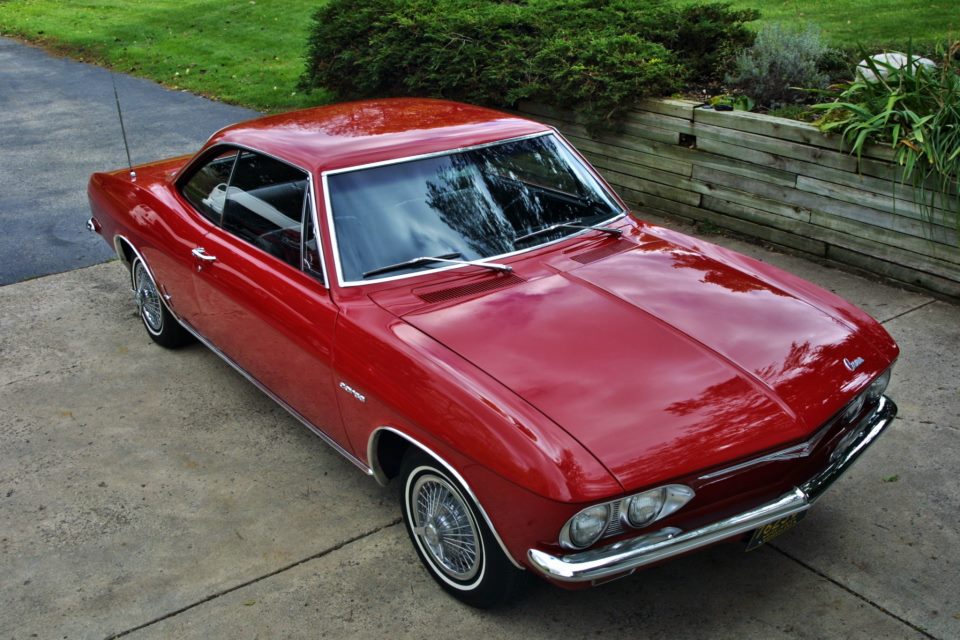
1965 Corvair Corsa Coupe

1965 Corvair Corsa Convertible
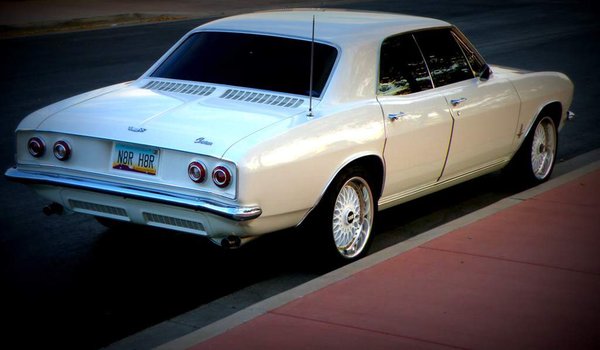
1965 Corvair Monza 4-Door Sedan
Corsa Interior (Top) / Monza Interior (Bottom)
140 hp 164 CI 4x1 Carburetor Engine (1965-1969)
Corvairs can suffer from rust and body rot problems, especially in areas that use a lot of road salt in the wintertime. While you may be able to learn and successfully attack most mechanical issues as a DIY effort, body decay can be much-more difficult, time-consuming, intimidating, and expensive to correct. So look for hidden rust or rot problems that may have been covered up with plastic filler, and be cautious in your Corvair selection.
A Corvair can serve well as a daily driver. But I would recommend a backup car or other alternatives, since ANY breakdown can put the car out of service for days until replacement parts can be obtained (if needed). If you have the skills and ability to work on the car yourself, repairs can often be completed fairly quickly. But if you have to rely on professional mechanics, downtime can be long and possibly expensive — if you can find a good mechanic to do the work for you.A Corvair can serve well as a daily driver. But I would recommend a backup car or other alternatives, since ANY breakdown can put the car out of service for days until replacement parts can be obtained (if needed). If you have the skills and ability to work on the car yourself, repairs can often be completed fairly quickly. But if you have to rely on professional mechanics, downtime can be long and possibly expensive — if you can find a good mechanic to do the work for you.bbodie52 wrote:Here is something I wrote over a year ago — Brad's Admonition, or some words of advice — based on over 50 years of exposure to Corvair ownership — that I wrote to try to give new Corvair buyers some idea of the issues involved. I'm sure you have some idea already, but I also think this is worth considering...
Since you are new to Corvairs, I want to give you some information that I have written to other new prospective first-time Corvair owners. I have been involved with Corvairs since I was eight years old, when my parents bought our first Corvair – a brand new 1961 Monza 2-door coupe, white on red with a 4-speed transmission. I now own Corvair number ten, which I purchased in June 2012. (If you want to read a brief personal biography that outlines my family background and our experiences with Corvairs, go to CORVAIR FORUM > Introductions > New from Lake Chatuge North Carolina. viewtopic.php?f=13&t=4032 ) I want to encourage your enthusiasm in developing your plans to buy your first Corvair, but at the same time I want to help you to think through just what you are getting into. So please read and consider these comments below...
I have listened to many potential Corvair first-time owners. Many have no prior experience with owning any classic car, and many have never driven a Corvair at all, or have not driven one in decades. Some are motivated by childhood memories of a family Corvair. They typically describe the desire to locate a perfect, restored, ultra-clean example, and look to the Corvair Forum Corvair enthusiasts and aficionados to tell them what to do.
The first thing I think that needs to be done is to try to set-aside the usual emotion-based enthusiasm that any car buyer might feel when visiting a dealer and gazing with emotional eagerness at the vast array of new cars displayed in the showroom, on the car lot, and in factory brochures and advertisements. There is an extreme difference between owning a 50+ year-old Chevrolet that was likely engineered, designed and built with pre-planned obsolescence in mind — a car that GM only envisioned having a life-span of ten years or so. Many of the potential Corvair buyers are captivated with the exciting idea of owning something different — something not normally seen on the road — something that your neighbor will not buy! Certainly that is the case with a Corvair, but owning a Corvair and enjoying that ownership demands a certain dose of reality before you "buy-in". Many are unprepared for the maintenance and upkeep demands of a Corvair. "Where can I find a good Corvair mechanic?" is a common question — often displaying an inability or unwillingness to do some mechanical work and maintain that car yourself. Yet qualified Corvair mechanics can be distant, expensive, inconvenient, and all-too rare. At a time when finding even a spark plug, fan belt, or oil filter for a Corvair often means an Internet or mail-order purchase, finding local support may be unlikely or impossible. Even searching automobile junk yards will often not help, because these cars are so rare and infrequently found that they have all but disappeared from the scrap yards too. Even locating and buying a used part is a mail-order proposition. And even if you spend $15,000-$20,000 for a fully-restored Corvair in mint condition, it still comes "as-is", with no warranty and little in the way of a local support system — far different than what most car buyers are used to expecting! These are the realities of owning an older classic car.
Corvairs are popular and affordable classic cars, and enjoy a good infrastructure of maintenance supporters, owner's clubs, and parts suppliers — and that REALLY helps! But I suspect that most happy Corvair owners are something of "shade-tree mechanics" and hobbyists who are prepared to deal with the risks and problems related to Corvair ownership. It requires a long-term commitment and a dose of reality to happily own a classic Corvair. The "first date" infatuation with the attractiveness and uniqueness of a Corvair will not sustain you in a long-term relationship with a Corvair. It is far-better to have a realistic idea of just what you are getting into before you "take the plunge" and buy your dream car.
A cautious, knowledgeable and educated search for your dream Corvair is a great start, and a careful and realistic analysis of your own mechanical talents, skills and abilities is also useful. If you plan to have a mechanic do most of the work for you, the availability of a Corvair-skilled mechanic and the associated costs involved must be taken into account in your financial planning to own a Corvair.
I try to not be too negative, but I have worked with others who came to realize that Corvair ownership was more than they could handle. I just feel that new prospective Corvair owners come here to this forum to learn from others who have more experience, and we are not doing them any favors by "candy coating" the issues involved. If they pass the "sanity check" and still want to pursue buying a Corvair, then GREAT! This Forum and perhaps some local Corvair club members can potentially help them pursue that dream. But it should be a realistic dream, and not a frustrating "nightmare" experience. Better to make a clear-headed, informed decision early in the game!
I hope that these comments are useful to you. I know I get "long-winded", but I also know you are trying to make an important decision, and I hope all of these comments will help you.
eBay is one possibility...
CORVAIRS FOR SALE
https://ssl.corvair.com/user-cgi/pages. ... =buyorsell
Just Listed!
https://www.corvair.org/go-shopping
Chevrolet Corvair for Sale
http://www.hemmings.com/classifieds/car ... et/corvair
Classifieds for Classic Chevrolet Corvair
http://classiccars.com/listings/find/al ... et/corvair
http://www.oldride.com/classic_cars/che ... rvair.html
Corvairs for Sale
https://www.facebook.com/pages/Corvairs ... 7975069947
https://www.gatewayclassiccars.com/
Even a
for "Corvairs for Sale" will produce many leads.
If you can tell us a little more abut your interest in Corvairs, your mechanical "DIY" knowledge and experience, the price range you are considering, and whether or not you would be willing to ship/transport a good find, members of the Corvair Forum may be able to provide you with some useful leads!

Last edited by bbodie52 on Thu Nov 02, 2023 8:55 am, edited 1 time in total.
Brad Bodie
Lake Chatuge, North Carolina
 1966 Corvair Corsa Convertible
1966 Corvair Corsa Convertible
Lake Chatuge, North Carolina
 1966 Corvair Corsa Convertible
1966 Corvair Corsa ConvertibleRe: WTB LM Convertible
Brad covered the issues with corrosion in the 65-68 convertibles. One advantage you have is wanting an automatic. When I check online ads I find automatic convertibles are as common as manual transmission convertibles and usually sell for less money.
I'll warn that even in Western states I found a number of "rust bucket" convertibles when I was looking. Your really have to know what to look for and GO LOOK, or hire someone who knows what to look for. I'd also suggest you find out what the yearly differences are. Every year changes were made making some years easier to get parts for and there is desirability depending on model year.
Good luck with your search.
- caraholic4life
- Posts: 568
- Joined: Mon Mar 22, 2010 5:19 pm
- Location: Westminster, Maryland
Re: WTB LM Convertible
I have a 1965 Monza convertible with a powerglide and manual top available.
The car has a clear Maryland Title in my name.
After seeing your post, I went ahead and posted it in the Classified section.
http://www.corvairforum.com/forum/viewtopic.php?t=18942
This may or may not be what you are looking for.
The car has a clear Maryland Title in my name.
After seeing your post, I went ahead and posted it in the Classified section.
http://www.corvairforum.com/forum/viewtopic.php?t=18942
This may or may not be what you are looking for.
1962 95 FC Van
1964 Greenbrier Deluxe
1965 Monza Coupe
1965 Monza Convertible
Mid Engine enthusiast &
Prior Kelmark Owner
1964 Greenbrier Deluxe
1965 Monza Coupe
1965 Monza Convertible
Mid Engine enthusiast &
Prior Kelmark Owner
- Timothy Shortle
- Posts: 2
- Joined: Wed Apr 24, 2024 6:10 pm
Re: WTB LM Convertible
I am curious, why are you not interested in a 69 Monza Convertible?
Re: WTB LM Convertible
"ajviper" only made that one post above and hasn't logged in here since last November so you might not get a reply. My guess as to why he didn't want a 69 was the fact that final-year cars are made from leftovers. I avoid anything after 66 myself.Timothy Shortle wrote: ↑Wed Apr 24, 2024 6:28 pm I am curious, why are you not interested in a 69 Monza Convertible?
Dave W. from Gilbert, AZ
66 Corsa 140/4 Yenko Stinger Tribute
66 Corsa 140 Coupe w/factory A/C
65 Monza 4DR 140/PG w/factory A/C
65 Monza 4DR EJ20T/5
64 Greenbrier 110/PG, Standard 6-Door
66 Corsa 140/4 Yenko Stinger Tribute
66 Corsa 140 Coupe w/factory A/C
65 Monza 4DR 140/PG w/factory A/C
65 Monza 4DR EJ20T/5
64 Greenbrier 110/PG, Standard 6-Door
